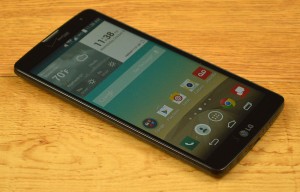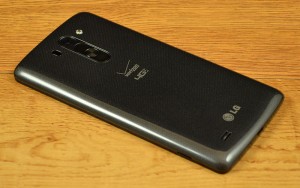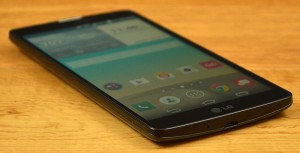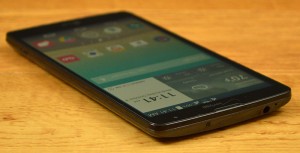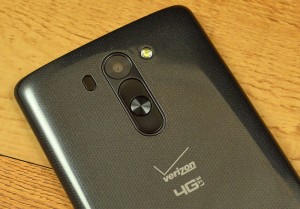Samsung and Apple sit atop the phablet market with the Galaxy Note series and iPhone 6 Plus. The LG G Vista sits, well, somewhere a few steps below, both in price and in specs. At a glance, it’s tough to discern the Android-powered Vista from its higher-end counterparts, as it’s large, black, and sleek, with a 5.7-inch display and thin bezel.
But looks can be deceiving. One touch is all it takes to reveal this Android phablet isn’t a flagship device. Its sleek, plastic build is just about the greasiest thing going in mobile. It literally feels icky.
As of this review, the LG G Vista is $50 on contract for both AT&T and Verizon, and $355 and $400 off contract, respectively.
Build and Design
The LG G Vista is a big smartphone. Its 5.7-inch display matches the Galaxy Note 4, and exceeds the iPhone 6 Plus by 0.2 inches. Overall, it measures 5.99 x 3.12 x 0.36 inches (HWD), making it far from pocketable, and likely too large for most to use with one hand, or even palm. Thankfully, it’s light, weighing just 5.93 ounces, and its rounded edges do much to make it as ergonomic as possible.
So it looks good, or at least better than its mid-range billing would suggest. The large display dominates the front, with little bezel on the sides, and a bit more on the top and bottom. The ear piece rests on the top, delineated by a thin metallic strip, and the front-facing 1.3-megapixel shooter is to the right of that.
There are no back and home softkeys on the bottom bezel as Android moves toward on-screen keys, which is fine as there’s barely enough room for them. Instead an LG logo sits center bottom, accompanied by a Verizon logo that resides center top, under the ear piece.
Being an LG smartphone, the textured volume rocker and power button sit centered on the upper rear portion of the G Vista, just below the 8-megapixel rear camera. The laser autofocus and flash reside to the left and right, respectively. The on-board speaker is on the bottom left corner.
Users can pry the back panel off to reveal the removable 3,200mAh lithium ion battery, microSIM card slot, and microSD card slot.
The left and right sides are featureless, sans a small opening to assist with removing the back panel. A microUSB input and microphone pinhole sit on the bottom, while the top houses a headphone jack, microphone pinhole, and IR blaster.
On paper, there’s little to complain about. Laser autofocus is a premium feature, the IR blaster is a nice addition, and the removable battery and expandable storage are big plusses.
In hand, it’s a different story. The LG G Vista is all plastic, and it feels grossly slick. The back panel has no texture and it’s a smudge magnet. Pity the poor G Vista user with sweaty palms.
The LG G Vista also creeks a bit under moderate stress, likely due in part to its thin build and large size, and even accounting for its removable rear panel. It has a Gorilla Glass display so it’s safe from scratches and shattering, but it’s likely not immune to the same forces propelling the iPhone 6 Plus and what many of dubbed “Bendgate.”
Users will certainly want to test the LG G Vista in person to see how they get along with the rear button setup. For a device this size, which is tough to palm completely, the advantage of rear buttons is clear, particularly for one-handed control. But it takes some getting used to, and the power button and the volume rocker have a very similar texture so it’s difficult to differentiate between the two. Also, their proximity to the lens is troublesome as it makes the lens all too vulnerable to an accidental finger tap and smudge.
Display and Speaker
The LG G Vista has a 5.7-inch Gorilla Glass 3 IPS LCD display with a 1280 x 720 resolution, which is good for about 258 pixels per inch. For some perspective, the Galaxy Note 4 also has a 5.7-inch display, but with 2560 X 1440 resolution and a whopping 515 pixels per inch.
So that’s where the G Vista display stands against the latest and greatest. The good news is that on its own, it’s perfectly serviceable.
Streaming video looks just fine, as does text. The colors tend toward the warmer tones, and the contrast is acceptable for an LCD panel. It’s not overly bright at the max settings, and glare presents issues, especially because it’s a particularly smudge happy and reflective display. But a lot of smartphones with LCD displays share those problems.
In fact, smartphone display technology has come so far in recent years, that even mid-range units have decent screens. The difference is certainly noticeable if one compares the Note 4 and G Vista side by side, but it’s still a case of good versus great.
It’s the opposite with smartphone speakers. Even the “good” smartphone speakers do a lousy job spitting out audio. The LG G Vista’s output is a bit below “good.” It’s loud and clear enough for personal use, but sounds especially flat. It would be best to stick with headphones for any movies or music.
The post LG G Vista Review appeared first on Brighthand.com.
